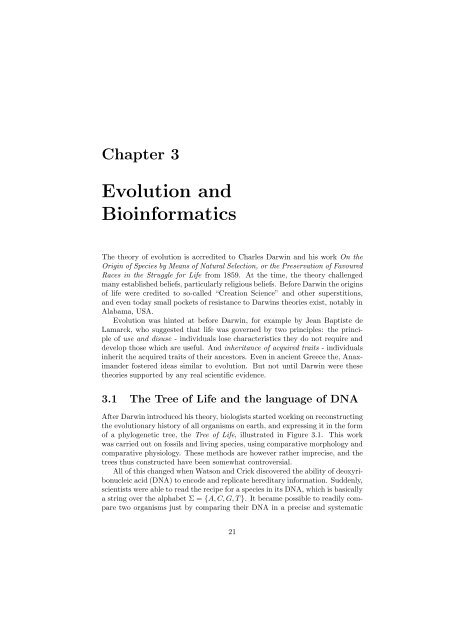Refined Buneman Trees
Refined Buneman Trees
Refined Buneman Trees
You also want an ePaper? Increase the reach of your titles
YUMPU automatically turns print PDFs into web optimized ePapers that Google loves.
Chapter 3<br />
Evolution and<br />
Bioinformatics<br />
The theory of evolution is accredited to Charles Darwin and his work On the<br />
Origin of Species by Means of Natural Selection, or the Preservation of Favoured<br />
Races in the Struggle for Life from 1859. At the time, the theory challenged<br />
many established beliefs, particularly religious beliefs. Before Darwin the origins<br />
of life were credited to so-called “Creation Science” and other superstitions,<br />
and even today small pockets of resistance to Darwins theories exist, notably in<br />
Alabama, USA.<br />
Evolution was hinted at before Darwin, for example by Jean Baptiste de<br />
Lamarck, who suggested that life was governed by two principles: the principle<br />
of use and disuse - individuals lose characteristics they do not require and<br />
develop those which are useful. And inheritance of acquired traits - individuals<br />
inherit the acquired traits of their ancestors. Even in ancient Greece the, Anaximander<br />
fostered ideas similar to evolution. But not until Darwin were these<br />
theories supported by any real scientific evidence.<br />
3.1 The Tree of Life and the language of DNA<br />
After Darwin introduced his theory, biologists started working on reconstructing<br />
the evolutionary history of all organisms on earth, and expressing it in the form<br />
of a phylogenetic tree, the Tree of Life, illustrated in Figure 3.1. This work<br />
was carried out on fossils and living species, using comparative morphology and<br />
comparative physiology. These methods are however rather imprecise, and the<br />
trees thus constructed have been somewhat controversial.<br />
All of this changed when Watson and Crick discovered the ability of deoxyribonucleic<br />
acid (DNA) to encode and replicate hereditary information. Suddenly,<br />
scientists were able to read the recipe for a species in its DNA, which is basically<br />
a string over the alphabet Σ = {A, C, G, T }. It became possible to readily compare<br />
two organisms just by comparing their DNA in a precise and systematic<br />
21
















